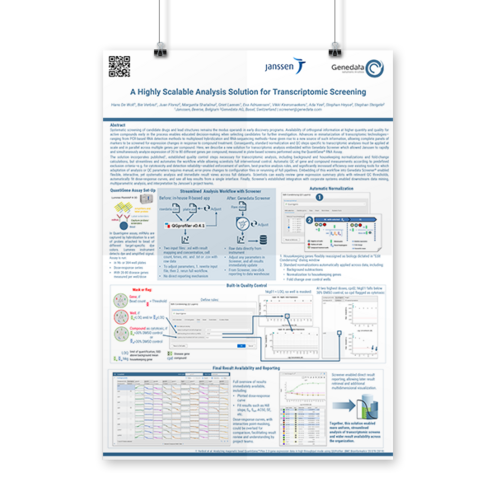ポスター:Janssen社、トランスクリプトミックスクリーニングのための拡張性の高い解析ソリューション
SLAS, San Diego, Ca, USA
January 27, 2020
Systematic screening of candidate drugs and lead structures remains the modus operandi in early discovery programs. The success of these programs is enhanced by earlier availability, greater amount and higher quality of orthogonal information, to enable educated decision-making when selecting drug candidates for further investigation. Advances in the miniaturization of transcriptomic technologies—ranging from PCR-based RNA detection methods to multiplexed hybridization and RNA-sequencing methods— has given rise to a new source of such information, by allowing complete panels of markers to be screened for expression changes in response to compound treatment. Consequently, many standard normalization and QC steps required for transcriptomic analyses must be applied at scale and in parallel across multiple genes per compound. Here, we describe a new solution embedded within Genedata Screener which allowed Janssen to rapidly and simultaneously analyze expression for 20 to 80 different genes per compound, measured in plate-based screens performed using the QuantiGene® RNA Assay.
The solution incorporates published [1], established quality control steps necessary for transcriptomic analysis, including background and housekeeping normalizations and fold-change calculations, but streamlines the workflow while allowing scientists full interventional control. Automatic QC of genes or compounds according to predefined exclusion criteria—including for cytotoxicity and detection reliability—enabled enforcement of uniform, best-practice analysis rules, generating significant efficiency gains over existing analysis tools that require scientists to make manual, error-prone changes to configuration files or to rerun complete pipelines in order to adjust analysis or QC parameters. The embedding of this workflow into Genedata Screener enables great flexibility and interactivity, by allowing quick application of such adjustments and immediate viewing of results across a full dataset. For instance, scientists can easily and intuitively review gene expression summary plots with relevant QC thresholds, automatically fit dose-response curves, and review key result values all within a single interface. Finally, export of compound and well-level results enabled future downstream data mining, multiparametric visualization, and interpretation.
[1] Verbist, B., Adriaensen, E., Keersmaekers, V. et al. Analyzing magnetic bead QuantiGene® Plex 2.0 gene expression data in high throughput mode using QGprofiler. BMC Bioinformatics 20, 378 (2019)
